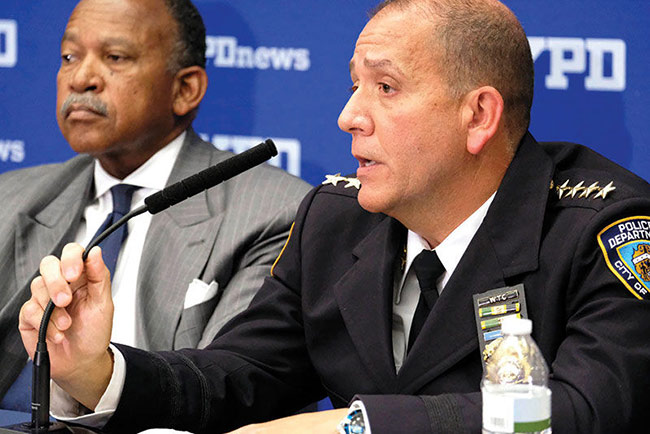





LOOK! UP IN THE SKY! IT’S THE NYPD: Chief of Patrol Carlos Gomez describes precautions taken by the Police Department to try to forestall a sniper attack like the one in Las Vegas. Officers ‘are perched on the rooftops, balconies or windows up in the buildings’ at major events, he said. And the Aviation Unit is called into play.
Discussing steps the NYPD takes to avoid a mass shooting like the one that occurred Oct. 1 in Las Vegas, police officials said last week that many officers are assigned to watch for trouble at major events but that members of the public must be sensitive to danger as well.
“We routinely utilize counter-sniper teams and observation teams at many of our large events,” Chief of Department Carlos Gomez said at an Oct. 3 press conference on crime statistics. “These are officers from the elite Emergency Services Unit. They are perched on the rooftops, balconies or windows up in the buildings.”
‘Aviation’ Seconds Away
“We often supplement that deployment with officers from Patrol on rooftops to serve as extra sets of eyes. As well, as you said, our Aviation Unit is assigned to many of our large details and they are seconds away from wherever they are in the city.”
Referring to a Yankees playoff game scheduled that night, he said, “We will have observation teams. We will have counter-sniper teams, as well as more resources and more heavy-weapons teams.”
Anyone seeking to harm New Yorkers “is going to see a whole lot of firepower around,” Mayor de Blasio said.
Deputy Commissioner of Intelligence and Counterterrorism John Miller added that every major event “gets a complex counterterrorism overlay.”
One focus of the department, he said, “involves the training program run by the Counterterrorism Bureau where 9,900 cops…have gone through active-shooter tactics training. That has been focused largely on the patrol forces in uniform. These are going to be the people who are going to get the call first and get there first.”
‘Active-Shooter Training’
The Intelligence Bureau, he said, runs classes for hotel employees. “We give them specialized training on recognition—recognition of suspicious activity on the part of guests, recognition of explosive precursors, what do those look like,” he said.
“This week we have added to that recognition of what everybody knows what a rifle looks like but what does a gun case look like? As opposed to a golf bag or regular luggage.
“...This training occurs relatively often because of the turnover in those jobs. We don’t focus just on the security people but also the key housekeeping staff. Those are the people who are in and out of the rooms who have the best observation ability to spot something suspicious.”
Further, he said, more than 57,000 civilians have been trained in active-shooter tactics “based on the principles of run, hide, and fight.”
‘Can’t Just Be NYPD’
Discussing responsibility for spotting possible attacks, Police Commissioner James P. O’Neill said, “It can’t just be the NYPD. It’s got to be however many people are going to Yankee Stadium tonight, what is it, 50,000 people. You got to pay attention, maybe take your headphones off, look around. If there’s something that doesn’t look right, it’s up to you to flag down a cop or make that call to 911.”
In the Vegas shooting, Stephen Paddock, 64, broke the windows in his 32nd-floor suite at the Mandalay Bay Resort and Casino and fired down at thousands of people attending a country-music festival in an open field about 400 yards from the hotel.
The death toll by the middle of last week was 59, and hundreds were wounded. Mr. Paddock killed himself as police closed in. He had smuggled 23 weapons, including semi-automatic rifles, into the suite in his luggage.
He was described by his brother as a wealthy real-estate investor and heavy gambler. His motive for the shooting was not clear.